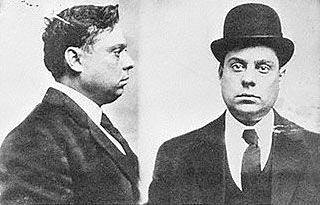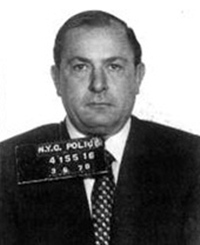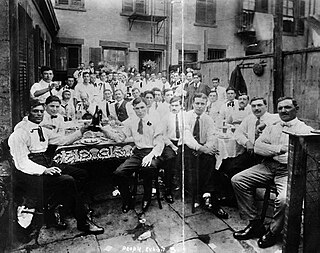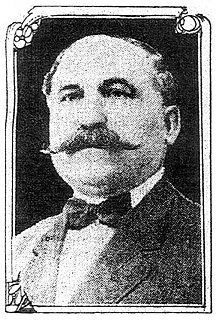
The Gambino crime family is one of the "Five Families" that dominate organized crime activities in New York City, United States, within the nationwide criminal phenomenon known as the American Mafia. The group, which went through five bosses between 1910 and 1957, is named after Carlo Gambino, boss of the family at the time of the McClellan hearings in 1963, when the structure of organized crime first gained public attention. The group's operations extend from New York and the eastern seaboard to California. Its illicit activities include labor and construction racketeering, gambling, loansharking, extortion, money laundering, prostitution, fraud, hijacking, and fencing.

The Genovese crime family is one of the "Five Families" that dominate organized crime activities in New York City and New Jersey as part of the American Mafia. They have generally maintained a varying degree of influence over many of the smaller mob families outside New York, including ties with the Philadelphia, Patriarca, and Buffalo crime families.
Nicolò Terranova, also known as Nicholas "Nick" Morello, was one of the first Italian-American organized crime figures in New York City. Along with his half-brother Giuseppe Morello and brothers Ciro and Vincenzo Terranova, he founded the Morello crime family, and was later one of the participants in the Mafia-Camorra War of 1915–17.

Giuseppe "the Clutch Hand" Morello, also known as "The Old Fox", was the first boss of the Morello crime family and later top adviser to Giuseppe "Joe the Boss" Masseria. He was known as Piddu and his rivals the Castellammarese knew him as Peter Morello. He was famous for having a one-fingered deformed right hand that resembled a claw.

The Morello crime family was one of the earliest crime families to be established in the United States and New York City. The Morellos were based in Manhattan's Italian Harlem and eventually gained dominance in the Italian underworld by defeating the rival Neapolitan Camorra of Brooklyn.
The Five Families is the organization of the five major New York City organized crime families of the Italian-American Mafia formed in 1931 by Salvatore Maranzano following his victory in the Castellammarese War.

Ignazio Lupo, also known as Ignazio Saietta and Lupo the Wolf, was a Sicilian American Black Hand leader in New York City during the early 1900s. His business was centered in Little Italy, Manhattan, where he ran large extortion operations and committed other crimes including robberies, loan-sharking, and murder. By the start of the 20th century, Lupo merged his crew with others in the South Bronx and East Harlem to form the Morello crime family, which became the leading Mafia family in New York City.

The Colombo crime family is the youngest of the "Five Families" that dominate organized crime activities in New York City within the criminal organization known as the American Mafia. It was during Lucky Luciano's organization of the American Mafia after the Castellammarese War, following the assassinations of "Joe the Boss" Masseria and Salvatore Maranzano, that the gang run by Joseph Profaci became recognized as the Profaci crime family.
Stefano "Steve" Ferrigno was a New York City mobster of Sicilian origin who led an important Italian criminal gang in the 1920s. Ferrigno was murdered along with Alfred Mineo during the so-called Castellammarese War.

Ciro Terranova was an Italian-born New York City gangster and one time underboss of the Morello crime family.
Alfonso Sgroia also known as "The Butcher" was a New York gang member who became a hitman for the Neapolitan Camorra gang.
The Mafia–Camorra War was a gang war in New York City that lasted from 1915-1917. On one side was the originally Sicilian Morello crime family of Manhattan; on the other side were gangs originally from Naples and the surrounding Campania region, based in Navy Street in Brooklyn and Coney Island referred to as the Camorra. The fight over the control of the New York rackets started after the killing of Giosue Gallucci, the undisputed King of Little Italy, and his son on May 17, 1915. The trials that followed in 1918 completely smashed the Camorra gangs; the protection that they enjoyed was demolished from the testimonies of their own men. It was the end of the Camorra in New York and the rise in power of American-based Sicilian Mafia groups.
Rocco Valenti was a New York City gangster and prominent member of the Camorra in New York during the early 1910s.
Pellegrino Morano (1877–????) was the head of a group of Neapolitans criminals with roots in the Camorra based in Coney Island, where he owned the Santa Lucia restaurant, which was often used as the headquarters for their gang, known as the Coney Island gang. He is also known as Marano.

Ralph "The Barber" Daniello (1886–1925) was a New York criminal who belonged to the Brooklyn Navy Street Gang and participated in a major gang slaying. Daniello eventually became an informant and helped destroy the Camorra crime gangs in Brooklyn.
The 116th Street Crew, also known as the Uptown Crew, is a powerful crew within the Genovese crime family. In the early 1960s, Anthony Salerno became one of the most powerful capos in the family. Salerno based the crew out of the Palma Boys Social Club located 416 East 115th Street in East Harlem, Manhattan. By the late 1970s and early 1980s, the 116th Street Crew had absorbed and initiated many former members of the vicious East Harlem Purple Gang, an Italian-American murder for hire and drug trafficking gang operating in 1970s Italian Harlem and acting generally independent of the Mafia.
Antonio Paretti, also known as Tony Paretti or Tony the Shoemaker, was a Camorra gangster. He was a member of the Brooklyn-based Coney Island gang in New York City, serving as the right-hand man of Pellegrino Morano.

The Brooklyn Camorra or New York Camorra was a loose grouping of early-20th-century organized crime groups that formed among Italian immigrants originating in Naples and the surrounding Campania region living in Greater New York, particularly in Brooklyn. In the early 20th century, the criminal underworld of New York City consisted largely of Italian Harlem-based Sicilians and groups of Neapolitans from Brooklyn, sometimes referred to as the Brooklyn Camorra, as Neapolitan organized crime is referred to as the Camorra.

Giosuè Gallucci, also known as Luccariello, was a crime boss of Italian Harlem in New York City affiliated with the Camorra. He dominated the area from 1910–1915 and was also known as the undisputed "King of Little Italy" and "The Mayor of Little Italy", partly due to his political connections. He held strict control over the policy game, employing Neapolitan and Sicilian street gangs as his enforcers.









